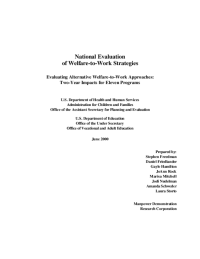Evaluating Alternative Welfare-to-Work Approaches
Two-Year Impacts for Eleven Programs
The Personal Responsibility and Work Opportunity Reconciliation Act of August 1996 ended the Aid to Families with Dependent Children (AFDC) program, one of the nation’s principal safety nets for poor families. Among its provisions, the law replaced AFDC with a block grant program, Temporary Assistance for Needy Families (TANF), and created financial incentives for states to run mandatory, work-focused welfare-to-work programs. While these types of programs are not new, various aspects of the 1996 law increase their importance: federal funds now may not be used to support most families on welfare for longer than five years and a number of states and localities have shorter welfare time limits; states face financial penalties if they fail to meet TANF-defined “participation standards,” which require large proportions of welfare recipients to be in work or work-related activities; and states must have a plan for how they will require recipients to work after two years of assistance.
To meet the new challenges of the federal welfare legislation, state and local administrators and policy makers need to know about the types of welfare-to-work program approaches that can quickly move substantial numbers of people into work and off welfare. This report provides such guidance, by analyzing the effectiveness of 11 mandatory welfare-to-work programs operated in seven locales. The sites included in the evaluation are Atlanta, Georgia; Columbus, Ohio; Detroit and Grand Rapids, Michigan; Oklahoma City, Oklahoma; Portland, Oregon; and Riverside, California.
The report is one in a series from an evaluation of the programs called the National Evaluation of Welfare-to-Work Strategies (NEWWS), conducted by the Manpower Demonstration Research Corporation (MDRC) under contract to the U.S. Department of Health and Human Services (HHS), with support from the U.S. Department of Education. Child Trends, as a subcontractor, is conducting the analyses of outcomes for young children (the Child Outcomes Study). Two other recent reports (both also published in 2000 by the U.S. Department of Health and Human Services, Administration for Children and Families and Office of the Assistant Secretary for Planning and Evaluation, and the U.S. Department of Education) should be viewed as “companion” documents to this report: Impacts on Young Children and Their Families Two Years After Enrollment: Findings from the Child Outcomes Study, prepared by Sharon M. McGroder, Martha J. Zaslow, Kristin A. Moore, and Suzanne M. LeMenestrel, Child Trends; and Do Mandatory Welfare-to-Work Programs Affect the Well-Being of Children? A Synthesis of Child Research Conducted as Part of the National Evaluation of Welfare-to-Work Strategies, prepared by Gayle Hamilton, MDRC, with Stephen Freedman, MDRC, and Sharon M. McGroder, Child Trends.
Each of the 11 studied programs operated under the federal Job Opportunities and Basic Skills Training (JOBS) program, which preceded TANF. Unlike TANF, these programs did not impose a time limit on eligibility for welfare assistance. However, they shared TANF’s primary goal of moving welfare recipients into paid work and off assistance. Further, among the 11 programs some are strongly employment-focused, the welfare-to-work strategy favored under TANF, and some are strongly basic education-focused, an approach possible under TANF but more prevalent during the late 1980s and early 1990s. (Overall, the present results pertain to the period between 1991 and 1996.) The programs varied in other ways, including how broadly the participation mandate was applied to the welfare caseload and how strictly it was enforced, the amount of child care support provided for program participation or employment, and methods of case management. The programs also served different welfare populations and operated in a variety of labor markets.







